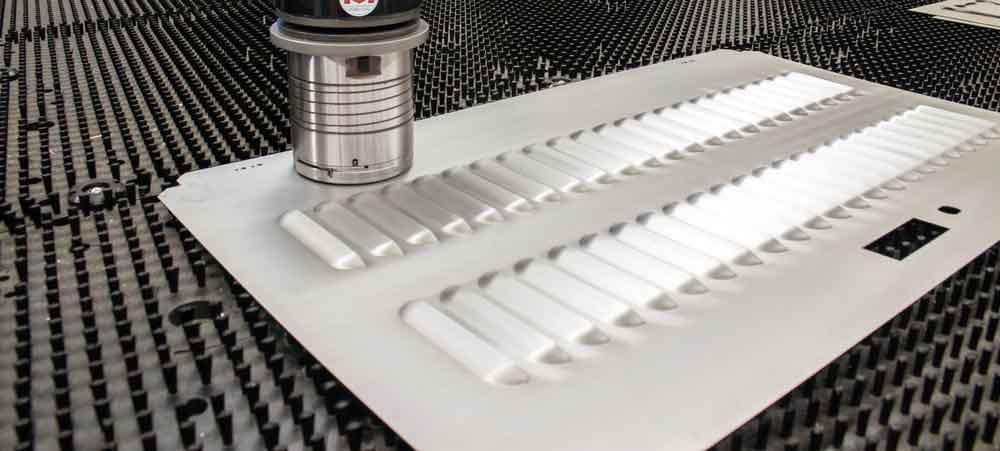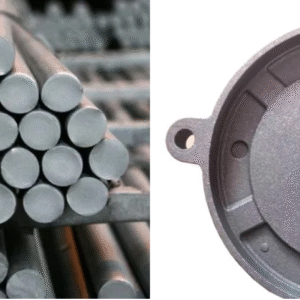Sheet metal punching demands aligning punch and die. The clearance might be from 5% to 10% of the material thickness to lower burrs and edge deformation. CNC-driven systems handle tool rotation, selective nibbling, and countersinking or embossing in a single pass. Meanwhile, punches use high-speed steel with coatings to decrease wear on stainless steel or aluminum. Material thickness can increase to around 6 mm in mild steel. It needs presses with higher tonnage for slug removal and part accuracy. Off-center loads cause ram deflection. So, some machines use hydraulic or servo-driven compensation to stay precise. Tool sharpening, lubrication, and stroke parameters outspread tool life and keep dimensional tolerances tight.
Benefits of Sheet Metal Punching
- High production speed.
- Dependable dimensional accuracy.
- Flexible shape creation.
- Low tooling costs.
- Negligible material wastage.
- Greater repeatability.
- Reduced lead times.
- Efficient process control.
- Appropriate for high-volume output.
- Permits multifaceted geometries
Types of Sheet Metals for Punching
- Mild Steel.
- Stainless Steel.
- Aluminum.
- Galvanized Steel.
- Brass.
- Copper.
- Titanium.
- Cold Rolled Steel.
- Hot Rolled Steel.
- High-Strength Low-Alloy (HSLA) Steel.
- Tool Steel.
- Carbon Steel.
Factors Affecting Quality of Sheet Metal Punching
Metallurgical Properties and Grain Orientation
Material microstructure influences how a workpiece responds to sheet metal punching. Metals with higher ductility produce cleaner edges but may give more springback. Tougher alloys demand tool steel or carbide punches to avoid deformation and galling. Grain orientation can also affect punch entry. It creates uneven shear zones for lower edge smoothness. Heat treatments that refine grain size help decrease micro-cracks during shearing in high-strength materials. Hardness balancing confirms that the punched edges resist tearing under high impact speeds. Monitoring microstructural variations is key to stable sheet metal punching.
Punch and Die Geometry
Punch and die clearance pushes successful sheet metal punching without burrs or fractures. A general rule is to set clearances per material thickness and yield strength. Still, setups adjust for partial shearing or near-net shaping. Tapered punches or concave dies help concentrate force and cut distortion. Rounded corners curb stress concentrations to avoid cracks in high-stress zones. Though more complex, compound dies permit multiple operations in one stroke for tighter tolerances and flatness. Fine-tuning such geometries helps attain expected punch shear behavior.
Press Tonnage and Ram Control
Insufficient press tonnage prompts incomplete penetration and inconsistent sheet metal punching. Excessive tonnage can over-shear edges, raising burr height. Presses with servo-controlled rams deliver hit speeds for lower impact shock on tooling. Stroke length calibration validates complete contact during the shearing stage for dimensional accuracy. Balanced force distribution keeps the workpiece stable and lessens lateral shifts under load. Some manufacturers integrate overload protection features that sense abnormal forces to inhibit catastrophic punch or die damage. Tight control of such parameters exploits punch life and conserves surface finish.
Tooling Condition and Coatings
Tool steel grade, surface finish, and coatings directly affect the life and quality of sheet metal punching. Hardened steels with low-friction titanium nitride coatings decrease adhesive wear during high-volume production. Micro-polishing the punch tip betters cutting action and lowers burr formation with a sharp, consistent contact edge. For abrasive stainless steel, multi-layered or diamond-like coatings can keep punch integrity and moderate galling. Scheduled checking of the punch tip radius or die alignment stops subtle wear from escalating into dimensional conflicts.
Environmental and Operational Factors
Lubrication is key to heat dissipation and friction reduction in sheet metal punching operations. High-viscosity fluids are used in alloy steels. Lighter oils suit thin aluminum or copper sheets. Temperature fluctuations inside the press area can alter material ductility to change shear characteristics. Clamping systems that counteract part movement lower misalignment and tool collision risk. Automated scrap removal and controlled vacuuming keep the die free from remnants that degrade subsequent hits. An operator’s vigilance in real-time press signals helps locate anomalies, including uneven tonnage buildup or sudden alignment shifts.
Quick Sheet Metal Punching Process
- Prepare the required design and tooling.
- Place the sheet metal on the punch press.
- Secure the sheet metal firmly.
- Align the punch tool with the target area.
- Initiate the punching operation.
- Inspect the punched holes for accuracy.
- Remove the finished sheet from the press.
Applications of Sheet Metal Punching
Sheet metal punching produces holes, louvered cutouts, and forms in automotive seat frames, aerospace brackets, and medical device enclosures. Engineers use CNC turret presses that keep micrometer-level tolerances across material thicknesses up to 6 mm. Aerospace applications demand louver patterns to cut weight and manage airflow. Correspondingly, automotive assemblies need repeatable hole placement for robotic assembly and alignment. Medical device housings benefit from deburred edges that lower contamination risks and meet regulatory standards. Multi-tool turrets can form extrusions, countersinks, and louvers in a single run.
Sheet Metal Punching Strategies
Strategic Tool Selection before Production
Analyzing part geometry, material thickness, and tolerance requirements helps strategize tooling for sheet metal punching. For convoluted shapes, custom punch profiles lessen secondary operations. Large open areas may call for staged punches that break down cuts into segments. High-hardness tools tackle ultra-high-strength steels without rapid wear. Conversely, flexible steel punches suit softer metals. Quick-change tooling can also update project setup in low-volume, high-mix scenarios. It saves time and certifies that each punch matches the application.
Progressive Die Configurations
Progressive dies combine multiple punch stages into one feed system for efficient sheet metal punching. Each station performs an operation, including piercing pilot holes or notching corners, before the final blanking. It lessens manual handling and improves strip progression. Sensor-based feedback at each station identifies misfeeds or material shifts. Die designs may incorporate pre-bending or embossing stages as part of a single stroke. As parts are formed and punched in sequence, negligible alignment errors occur to maintain close tolerances and repeatability.
CNC Integration and Nesting Optimization
CNC-controlled turrets bring precision to sheet metal punching with automated tool positioning, hit sequence, and stroke depth. Nesting algorithms pack multiple parts onto one sheet to save material and scrap. To adjust punch tooling usage, the software can analyze geometry, cutting paths, and part rotation. Servo-electric drives let operators adjust speed and dwell time on the fly for edge quality on contours. Data tracking also helps foretell tool wear or misalignment issues before they become costly. CNC-based monitoring confirms that each stroke is deliberate.
Inline Quality Inspection and Process Feedback
Cameras and sensors near the die station facilitate checks after every sheet metal punching stroke. Automated burr height measurement systems flag deviations. They help trigger an adjustment or alert. Some setups deploy laser scanning or thermographic imaging to assess edge integrity. The press control system can tweak speed, pressure, or alignment to resolve issues. The feedback loop helps maintain tolerance across large runs. In aerospace or medical applications, inline inspection averts micro-cracks or dimensional shifts for component reliability.
Burr Reduction and Post-Punch Finishing
Abating burrs is a priority in sheet metal punching for applications having smooth edges or subsequent joining. Lowering the punch-die clearance to a calculated range can curb burr formation. In some cases, a secondary shaving operation polishes the edges. Vibratory deburring, tumbling, or automated brushing helps meet surface specs. When dealing with high-tensile materials, heat treatments before punching can render shearing more uniform and decrease burr size. A controlled finishing stage verifies that parts are ready for downstream processes.
Looking for top-notch sheet metal punching services? ShanenTech is the best to consider.




